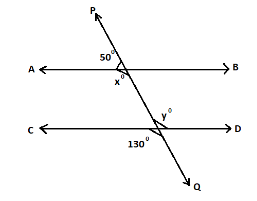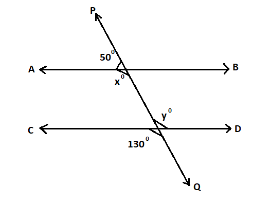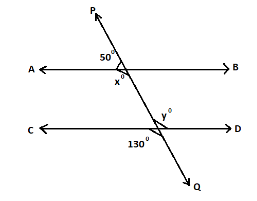
In the given figure, find the value of x and y then show that $AB\left\| {CD} \right.$.
Answer
556.2k+ views
Hint: According to given in the question we have to determine the value of x and y and then we have to show that$AB\left\| {CD} \right.$. So, first of all we have to consider the given image which is given as below:

Now, to find the value of ${x^\circ}$ as we know that line PQ is a straight line and the line PQ intersects the line AB hence, at the point of intersection the sum of both of the angles will be ${180^\circ}$ so, we can determine the value of ${x^\circ}$.
Now, to determine the value of ${y^\circ}$ we have to use the vertically opposite angle theorem which is explained as below:
Vertically opposite angles: when a straight line intersects another line then we can say that the vertical angles which are formed due to intersection are known as vertically opposite angles and they are equal to each other.
Now, to prove that $AB\left\| {CD} \right.$ we have to apply a transversal theorem according to this theorem if two lines are cut or intersected by a transversal and the alternate interior angles are congruent then the lines are parallel to each other.
Complete step-by-step solution:
Step 1: First of all we have to determine the angle or value of ${x^\circ}$ and to find the value of ${x^\circ}$ as we know that line PQ is a straight line and the line PQ intersects the line AB hence, at the point of intersection the sum of both of the angles will be ${180^\circ}$ so, we can determine the value of ${x^\circ}$ as mentioned in the solution hint. Hence,

$
\Rightarrow {x^\circ} + {50^\circ} = {180^\circ} \\
\Rightarrow {x^\circ} = {180^\circ} - {50^\circ} \\
\Rightarrow {x^\circ} = {130^\circ} \\
$
Step 2: Now, we have to determine the value of ${y^\circ}$ with the help of a vertically opposite angle theorem as mentioned in the solution hint. Hence, as given in the figure below:

$ \Rightarrow {y^\circ} = {130^\circ}$
Step 3: Now, we have to prove that lines $AB\left\| {CD} \right.$ and as we can see from the step 1 and step 2,
$ \Rightarrow \angle {x^\circ} = \angle {y^\circ}$ so, we have to apply transversal theorem according to this theorem if two lines are cut or intersected by a transversal and the alternate interior angles are congruent then the lines are parallel to each other as mentioned in the solution hint. Hence,
$AB\left\| {CD} \right.$ means line AB is parallel to the line CD.
Hence, with the help of vertical opposite angle theorem and transversal theorem as mentioned in the solution hint we have determined ${x^\circ} = {130^\circ}$, ${y^\circ} = {130^\circ}$ and $AB\left\| {CD} \right.$
Note: If a straight line intersects another line then we can say that the vertical angles which are formed due to intersections known as vertically opposite angles and they are equal to each other.
If two lines are cut or intersected by a transversal and the alternate interior angles are congruent then the lines are parallel to each other.

Now, to find the value of ${x^\circ}$ as we know that line PQ is a straight line and the line PQ intersects the line AB hence, at the point of intersection the sum of both of the angles will be ${180^\circ}$ so, we can determine the value of ${x^\circ}$.
Now, to determine the value of ${y^\circ}$ we have to use the vertically opposite angle theorem which is explained as below:
Vertically opposite angles: when a straight line intersects another line then we can say that the vertical angles which are formed due to intersection are known as vertically opposite angles and they are equal to each other.
Now, to prove that $AB\left\| {CD} \right.$ we have to apply a transversal theorem according to this theorem if two lines are cut or intersected by a transversal and the alternate interior angles are congruent then the lines are parallel to each other.
Complete step-by-step solution:
Step 1: First of all we have to determine the angle or value of ${x^\circ}$ and to find the value of ${x^\circ}$ as we know that line PQ is a straight line and the line PQ intersects the line AB hence, at the point of intersection the sum of both of the angles will be ${180^\circ}$ so, we can determine the value of ${x^\circ}$ as mentioned in the solution hint. Hence,

$
\Rightarrow {x^\circ} + {50^\circ} = {180^\circ} \\
\Rightarrow {x^\circ} = {180^\circ} - {50^\circ} \\
\Rightarrow {x^\circ} = {130^\circ} \\
$
Step 2: Now, we have to determine the value of ${y^\circ}$ with the help of a vertically opposite angle theorem as mentioned in the solution hint. Hence, as given in the figure below:

$ \Rightarrow {y^\circ} = {130^\circ}$
Step 3: Now, we have to prove that lines $AB\left\| {CD} \right.$ and as we can see from the step 1 and step 2,
$ \Rightarrow \angle {x^\circ} = \angle {y^\circ}$ so, we have to apply transversal theorem according to this theorem if two lines are cut or intersected by a transversal and the alternate interior angles are congruent then the lines are parallel to each other as mentioned in the solution hint. Hence,
$AB\left\| {CD} \right.$ means line AB is parallel to the line CD.
Hence, with the help of vertical opposite angle theorem and transversal theorem as mentioned in the solution hint we have determined ${x^\circ} = {130^\circ}$, ${y^\circ} = {130^\circ}$ and $AB\left\| {CD} \right.$
Note: If a straight line intersects another line then we can say that the vertical angles which are formed due to intersections known as vertically opposite angles and they are equal to each other.
If two lines are cut or intersected by a transversal and the alternate interior angles are congruent then the lines are parallel to each other.
Recently Updated Pages
Master Class 9 General Knowledge: Engaging Questions & Answers for Success

Master Class 9 English: Engaging Questions & Answers for Success

Master Class 9 Science: Engaging Questions & Answers for Success

Class 9 Question and Answer - Your Ultimate Solutions Guide

Master Class 12 Economics: Engaging Questions & Answers for Success

Master Class 12 Maths: Engaging Questions & Answers for Success

Trending doubts
Which places in India experience sunrise first and class 9 social science CBSE

Fill the blanks with the suitable prepositions 1 The class 9 english CBSE

Write the 6 fundamental rights of India and explain in detail

Difference Between Plant Cell and Animal Cell

What is pollution? How many types of pollution? Define it

What is the Full Form of ISI and RAW




